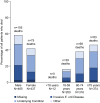Epidemiology, Clinical Features, and Antimicrobial Resistance of Invasive Escherichia Coli Disease in Patients Admitted in Tertiary Care Hospitals
- PMID: 36817744
- PMCID: PMC9933942
- DOI: 10.1093/ofid/ofad026
Epidemiology, Clinical Features, and Antimicrobial Resistance of Invasive Escherichia Coli Disease in Patients Admitted in Tertiary Care Hospitals
Abstract
Background: Invasive Escherichia coli disease (IED), including bloodstream infection, sepsis, and septic shock, can lead to high hospitalization and mortality rates. This multinational study describes the clinical profile of patients with IED in tertiary care hospitals.
Methods: We applied clinical criteria of systemic inflammatory response syndrome (SIRS), sepsis, or septic shock to patients hospitalized with culture-confirmed E coli from urine or a presumed sterile site. We assessed a proposed clinical case definition against physician diagnoses.
Results: Most patients with IED (N = 902) were adults aged ≥60 years (76.5%); 51.9%, 25.1%, and 23.0% of cases were community-acquired (CA), hospital-acquired (HA), and healthcare-associated (HCA), respectively. The urinary tract was the most common source of infection (52.3%). Systemic inflammatory response syndrome, sepsis, and septic shock were identified in 77.4%, 65.3%, and 14.1% of patients, respectively. Patients >60 years were more likely to exhibit organ dysfunction than those ≤60 years; this trend was not observed for SIRS. The case-fatality rate (CFR) was 20.0% (60-75 years, 21.5%; ≥75 years, 22.2%), with an increase across IED acquisition settings (HA, 28.3%; HCA, 21.7%; CA, 15.2%). Noticeably, 77.8% of patients initiated antibiotic use on the day of culture sample collection. A total of 65.6% and 40.8% of E coli isolates were resistant to ≥1 agent in ≥1 or ≥2 drug class(es). A 96.1% agreement was seen between the proposed clinical case definition and physician's diagnoses of IED.
Conclusions: This study contributes valuable, real-world data about IED severity. An accepted case definition could promote timely and accurate diagnosis of IED and inform the development of novel preventative strategies.
Keywords: Escherichia coli; blood culture; sepsis; septicemia.
© The Author(s) 2023. Published by Oxford University Press on behalf of Infectious Diseases Society of America.
Conflict of interest statement
Potential conflicts of interest. J. D., J. G., O. G., J. P., and M. S. are employees of Janssen and receive Janssen stock. P. H. was an employee of Janssen from 2012 to 2019 and since 2019 has been a Full Professor at UMC Utrecht. M. B. is chair of the international study steering committee for the E.mbrace study (Janssen Vaccines), with payments made to UMC Utrecht. S. G. consults/advises for Janssen. Conflicts that the editors consider relevant to the content of the manuscript have been disclosed.
Figures

References
-
- Russo TA, Johnson JR. Medical and economic impact of extraintestinal infections due to Escherichia coli: focus on an increasingly important endemic problem. Microbes Infect 2003; 5:449–56. - PubMed
-
- Russo TA, Johnson JR. Proposal for a new inclusive designation for extraintestinal pathogenic isolates of Escherichia coli: ExPEC. J Infect Dis 2000; 181:1753–4. - PubMed
-
- Rosenberg S, Bonten M, Haazen W, et al. . Epidemiology and O-serotypes of extraintestinal pathogenic Escherichia coli disease in patients undergoing transrectal ultrasound prostate biopsy: a prospective multicenter study. J Urol 2021; 205:826–32. - PubMed

